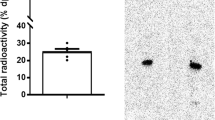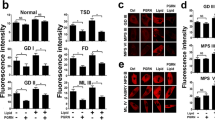Abstract
Sandhoff disease is an incurable neurodegenerative disorder caused by mutations in the lysosomal hydrolase β-hexosaminidase. Deficiency in this enzyme leads to excessive accumulation of ganglioside GM2 and its asialo derivative, GA2, in brain and visceral tissues. Small molecule inhibitors of ceramide-specific glucosyltransferase, the first committed step in ganglioside biosynthesis, reduce storage of GM2 and GA2. Limited brain access or adverse effects have hampered the therapeutic efficacy of the clinically approved substrate reduction molecules, eliglustat tartrate and the imino sugar NB-DNJ (Miglustat). The novel eliglustat tartrate analog, 2-(2,3-dihydro-1H-inden-2-yl)-N-((1R,2R)-1-(2,3-dihydrobenzo[b][1, 4]dioxin-6-yl)-1-hydroxy-3-(pyrrolidin-1-yl)propan-2-yl)acetamide (EtDO-PIP2, CCG-203586 or “3h”), was recently reported to reduce glucosylceramide in murine brain. Here we assessed the therapeutic efficacy of 3h in juvenile Sandhoff (Hexb−/−) mice. Sandhoff mice received intraperitoneal injections of phosphate buffered saline (PBS) or 3h (60 mg/kg/day) from postnatal day 9 (p-9) to postnatal day 15 (p-15). Brain weight and brain water content was similar in 3h and PBS-treated mice. 3h significantly reduced total ganglioside sialic acid, GM2, and GA2 content in cerebrum, cerebellum and liver of Sandhoff mice. Data from the liver showed that 3h reduced the key upstream ganglioside precursor (glucosylceramide), providing evidence for an on target mechanism of action. No significant differences were seen in the distribution of cholesterol or of neutral and acidic phospholipids. These data suggest that 3h can be an effective alternative to existing substrate reduction molecules for ganglioside storage diseases.





Similar content being viewed by others
Abbreviations
- GSL:
-
Glycosphingolipid
- GlcCer:
-
Glucosylceramide
- LSD:
-
Lysosomal storage disease
- SD:
-
Sandhoff disease
- 3h, EtDO-PIP2-oxalate:
-
Ethylenedioxy-PIP2-oxalate
- CCG-203586:
-
2-(2,3-dihydro-1H-inden-2-yl)-N-((1R,2R)-1-(2,3-dihydrobenzo[b][1, 4]dioxin-6-yl)-1-hydroxy-3-(pyrrolidin-1-yl)propan-2-yl)acetamide oxalate
- NGNA:
-
N-glycolylneuraminic acid
- NB-DNJ:
-
N-butyldeoxynojirimycin
- NB-DGJ:
-
N-butyldeoxygalactonojirimycin
References
Kolter T, Sandhoff K (2006) Sphingolipid metabolism diseases. Biochim Biophys Acta 1758:2057–2079
Sango K, Yamanaka S, Hoffmann A et al (1995) Mouse models of Tay-Sachs and Sandhoff diseases differ in neurologic phenotype and ganglioside metabolism. Nat Genet 11:170–176
Phaneuf D, Wakamatsu N, Huang JQ et al (1996) Dramatically different phenotypes in mouse models of human Tay-Sachs and Sandhoff diseases. Hum Mol Genet 5:1–14
Jeyakumar M, Butters TD, Dwek RA et al (2002) Glycosphingolipid lysosomal storage diseases: therapy and pathogenesis. Neuropathol Appl Neurobiol 28:343–357
Jeyakumar M, Thomas R, Elliot-Smith E et al (2003) Central nervous system inflammation is a hallmark of pathogenesis in mouse models of GM1 and GM2 gangliosidosis. Brain 126:974–987
Kyrkanides S, Miller AW, Miller JN et al (2008) Peripheral blood mononuclear cell infiltration and neuroinflammation in the HexB−/− mouse model of neurodegeneration. J Neuroimmunol 203:50–57
Platt FM, Neises GR, Karlsson GB et al (1994) N-butyldeoxygalactonojirimycin inhibits glycolipid biosynthesis but does not affect N-linked oligosaccharide processing. J Biol Chem 269:27108–27114
Ichikawa S, Hirabayashi Y (1998) Glucosylceramide synthase and glycosphingolipid synthesis. Trends Cell Biol 8:198–202
Baek RC, Kasperzyk JL, Platt FM et al (2008) N-butyldeoxygalactonojirimycin reduces brain ganglioside and GM2 content in neonatal Sandhoff disease mice. Neurochem Int 52:1125–1133
Arthur JR, Lee JP, Snyder EY et al (2012) Therapeutic effects of stem cells and substrate reduction in juvenile Sandhoff mice. Neurochem Res 37:1335–1343
Platt FM, Neises GR, Reinkensmeier G et al (1997) Prevention of lysosomal storage in Tay-Sachs mice treated with N-butyldeoxynojirimycin. Science (New York, N.Y) 276:428–431
Jeyakumar M, Butters TD, Cortina-Borja M et al (1999) Delayed symptom onset and increased life expectancy in Sandhoff disease mice treated with N-butyldeoxynojirimycin. Proc Natl Acad Sci USA 96:6388–6393
Kasperzyk JL, d’Azzo A, Platt FM et al (2005) Substrate reduction reduces gangliosides in postnatal cerebrum-brainstem and cerebellum in GM1 gangliosidosis mice. J Lipid Res 46:744–751
Kasperzyk JL, El-Abbadi MM, Hauser EC et al (2004) N-butyldeoxygalactonojirimycin reduces neonatal brain ganglioside content in a mouse model of GM1 gangliosidosis. J Neurochem 89:645–653
Andersson U, Butters TD, Dwek RA et al (2000) N-butyldeoxygalactonojirimycin: a more selective inhibitor of glycosphingolipid biosynthesis than N-butyldeoxynojirimycin, in vitro and in vivo. Biochem Pharmacol 59:821–829
Andersson U, Smith D, Jeyakumar M et al (2004) Improved outcome of N-butyldeoxygalactonojirimycin-mediated substrate reduction therapy in a mouse model of Sandhoff disease. Neurobiol Dis 16:506–515
Elliot-Smith E, Speak AO, Lloyd-Evans E et al (2008) Beneficial effects of substrate reduction therapy in a mouse model of GM1 gangliosidosis. Mol Genet Metab 94:204–211
Marshall J, Ashe KM, Bangari D et al (2010) Substrate reduction augments the efficacy of enzyme therapy in a mouse model of Fabry disease. PLoS ONE 5:e15033
Marshall J, McEachern KA, Chuang WL et al (2010) Improved management of lysosomal glucosylceramide levels in a mouse model of type 1 Gaucher disease using enzyme and substrate reduction therapy. J Inherit Metab Dis 33:281–289
Hollak CE, Hughes D, van Schaik IN et al (2009) Miglustat (Zavesca) in type 1 Gaucher disease: 5-year results of a post-authorisation safety surveillance programme. Pharmacoepidemiol Drug Saf 18:770–777
Lukina E, Watman N, Arreguin EA et al (2010) A phase 2 study of eliglustat tartrate (Genz-112638), an oral substrate reduction therapy for Gaucher disease type 1. Blood 116:893–899
Lukina E, Watman N, Arreguin EA et al (2010) Improvement in hematological, visceral, and skeletal manifestations of Gaucher disease type 1 with oral eliglustat tartrate (Genz-112638) treatment: 2-year results of a phase 2 study. Blood 116:4095–4098
Machaczka M, Hast R, Dahlman I et al (2012) Substrate reduction therapy with miglustat for type 1 Gaucher disease: a retrospective analysis from a single institution. Ups J Med Sci 117:28–34
Shayman JA (2010) ELIGLUSTAT TARTRATE: glucosylceramide synthase inhibitor treatment of type 1 Gaucher disease. Drugs Future 35:613–620
Cox TM, Aerts JM, Andria G et al (2003) The role of the iminosugar N-butyldeoxynojirimycin (miglustat) in the management of type I (non-neuronopathic) Gaucher disease: a position statement. J Inherit Metab Dis 26:513–526
Cox TM (2010) Eliglustat tartrate, an orally active glucocerebroside synthase inhibitor for the potential treatment of Gaucher disease and other lysosomal storage diseases. Curr Opin Investig Drugs 11:1169–1181
Brumshtein B, Greenblatt HM, Butters TD et al (2007) Crystal structures of complexes of N-butyl- and N-nonyl-deoxynojirimycin bound to acid beta-glucosidase: insights into the mechanism of chemical chaperone action in Gaucher disease. J Biol Chem 282:29052–29058
Alfonso P, Pampin S, Estrada J et al (2005) Miglustat (NB-DNJ) works as a chaperone for mutated acid beta-glucosidase in cells transfected with several Gaucher disease mutations. Blood Cells Mol Dis 35:268–276
McEachern KA, Fung J, Komarnitsky S et al (2007) A specific and potent inhibitor of glucosylceramide synthase for substrate inhibition therapy of Gaucher disease. Mol Genet Metab 91:259–267
Larsen SD, Wilson MW, Abe A et al (2012) Property-based design of a glucosylceramide synthase inhibitor that reduces glucosylceramide in the brain. J Lipid Res 53:282–291
Galjaard H (1979) Early diagnosis and prevention of genetic disease. Ann Clin Biochem 16:343–353
Baek RC, Martin DR, Cox NR et al (2009) Comparative analysis of brain lipids in mice, cats, and humans with Sandhoff disease. Lipids 44:197–205
Hauser EC, Kasperzyk JL, d’Azzo A et al (2004) Inheritance of lysosomal acid beta-galactosidase activity and gangliosides in crosses of DBA/2J and knockout mice. Biochem Genet 42:241–257
Macala LJ, Yu RK, Ando S (1983) Analysis of brain lipids by high performance thin-layer chromatography and densitometry. J Lipid Res 24:1243–1250
Seyfried TN, Glaser GH, Yu RK (1979) Genetic variability for regional brain gangliosides in five strains of young mice. Biochem Genet 17:43–55
Seyfried TN, Yu RK (1980) Heterosis for brain myelin content in mice. Biochem Genet 18:1229–1238
Lee JP, Jeyakumar M, Gonzalez R et al (2007) Stem cells act through multiple mechanisms to benefit mice with neurodegenerative metabolic disease. Nat Med 13:439–447
Denny CA, Heinecke KA, Kim YP et al (2010) Restricted ketogenic diet enhances the therapeutic action of N-butyldeoxynojirimycin towards brain GM2 accumulation in adult Sandhoff disease mice. J Neurochem 113:1525–1535
Ashe KM, Bangari D, Li L et al (2011) Iminosugar-based inhibitors of glucosylceramide synthase increase brain glycosphingolipids and survival in a mouse model of Sandhoff disease. PLoS ONE 6:e21758
Brigande JV, Platt FM, Seyfried TN (1998) Inhibition of glycosphingolipid biosynthesis does not impair growth or morphogenesis of the postimplantation mouse embryo. J Neurochem 70:871–882
Platt FM, Neises GR, Dwek RA et al (1994) N-butyldeoxynojirimycin is a novel inhibitor of glycolipid biosynthesis. J Biol Chem 269:8362–8365
Acknowledgments
This work was supported in part from NIH grants R21NS079633-1, 2RO1 DK055823, (JAS) and NS055195 (TNS) and the Boston College Research Expense Fund.
Author information
Authors and Affiliations
Corresponding author
Electronic supplementary material
Below is the link to the electronic supplementary material.
Rights and permissions
About this article
Cite this article
Arthur, J.R., Wilson, M.W., Larsen, S.D. et al. Ethylenedioxy-PIP2 Oxalate Reduces Ganglioside Storage in Juvenile Sandhoff Disease Mice. Neurochem Res 38, 866–875 (2013). https://doi.org/10.1007/s11064-013-0992-5
Received:
Revised:
Accepted:
Published:
Issue Date:
DOI: https://doi.org/10.1007/s11064-013-0992-5




